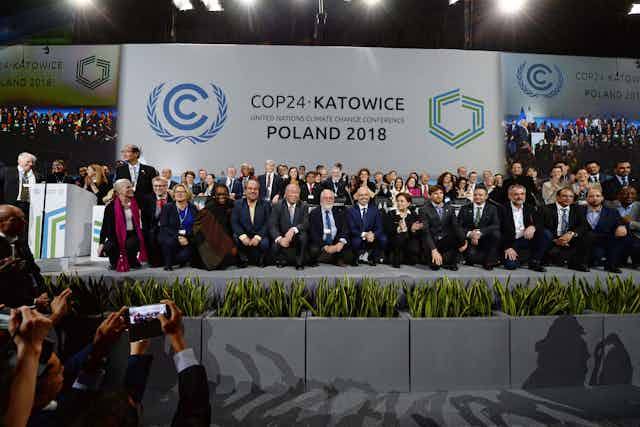Three years after the Paris Agreement was struck, we now finally know the rules – or most of them, at least – for its implementation.
The Paris Rulebook, agreed at the UN climate summit in Katowice, Poland, gives countries a common framework for reporting and reviewing progress towards their climate targets.
Yet the new rules fall short in one crucial area. While the world will now be able to see how much we are lagging behind on the necessary climate action, the rulebook offers little to compel countries to up their game to the level required.
Read more: COP24 shows global warming treaties can survive the era of the anti-climate ‘strongman’
The national pledges adopted in Paris are still woefully inadequate to meet the 1.5°C or 2°C global warming goals of the Paris Agreement. In the run-up to the Katowice talks, the Intergovernmental Panel on Climate Change released a special report detailing the urgent need to accelerate climate policy. Yet the summit ran into trouble in its efforts to formally welcome the report, with delegates eventually agreeing to welcome its “timely completion”.
Rather than directly asking for national climate targets to be increased, the Katowice text simply reiterates the existing request in the Paris Agreement for countries to communicate and update their contributions by 2020.
Much now hinges on the UN General Assembly summit in September 2019, to bring the much-needed political momentum towards a new raft of pledges in 2020 that are actually in line with the scientific reality.
Ratcheting up ambition
A key element of the Paris Agreement is the Global Stocktake - a five-yearly assessment of whether countries are collectively on track to meet the Paris Agreement’s goals to limit global warming.
The new rulebook affirms that this process will consider “equity and best available science”. But it does not elaborate specifically on how these inputs will be used, and how the outcomes of the stocktake will increase ambition.
This raises concerns that the rulebook will ensure we know if we are falling behind on climate action, but will offer no prescription for fixing things. This risks failing to address one of the biggest issues with the Paris Agreement so far: that countries are under no obligation to ensure their climate pledges are in line with the overall goals. A successful, ambitious and prescriptive five-yearly review process will be essential to get the world on track.
Transparency and accounting
One of the aims of the Katowice talks was to develop a common set of formats and schedules for countries to report their climate policy progress.
The new rules allow a degree of flexibility for the most vulnerable countries, who are not compelled to submit quantified climate pledges or regular transparency reports. All other countries will be bound to report on their climate action every two years, starting in 2024.
However, given the “bottom-up” nature of the Paris Agreement, countries are largely able to determine their own accounting rules, with guidelines agreed on what information they should provide. But a future international carbon trading market will obviously require a standardised set of rules. The newly agreed rulebook carries a substantial risk of double-counting where countries could potentially count overseas emissions reductions towards their own target, even if another country has also claimed this reduction for itself.
This issue became a major stumbling block in the negotiations, with Brazil and others refusing to agree to rules that would close this loophole, and so discussions will continue next year. In the meantime, the UN has no official agreement on how to implement international carbon trading.
Accounting rules for action in the land sector have also been difficult to agree. Countries such as Brazil and some African nations sought to avoid an agreement on this issue, while others, such as Australia, New Zealand and the European Union, prefer to continue existing rules that have delivered windfall credits to these countries.
Finance
The new rulebook defines what will constitute “climate finance”, and how it will be reported and reviewed.
Developed countries are now obliged to report every two years on what climate finance they plan to provide, while other countries in a position to provide climate finance are encouraged to follow the same schedule.
But with a plethora of eligible financial instruments – concessional and non-concessional loans, guarantees, equity, and investments from public and private sources – the situation is very complex. In some cases, vulnerable countries could be left worse off, such as if loans have to be repaid with interest, or if financial risk instruments fail.
Countries can voluntarily choose to report the grant equivalent value of these financial instruments. Such reporting will be crucial for understanding the scale of climate finance mobilised.
Read more: We can't know the future cost of climate change. Let's focus on the cost of avoiding it instead
The Paris Agreement delivered the blueprint for a global response to climate change. Now, the Paris Rulebook lays out a structure for reporting and understanding the climate action of all countries.
But the world is far from on track to achieving the goals of the Paris Agreement. The latest report from the UN Environment Programme suggests existing climate targets would need to be increased “around fivefold” for a chance of limiting warming to 1.5°C. The newly agreed rules don’t offer a way to put us on this trajectory.
Multilateral climate policy has perhaps taken us as far as it can – it is now time for action at the national level. Australia, as a country with very high per-capita emissions, needs to step up to a leadership position and take on our fair share of the global response. This means making a 60% emissions cut by 2030, as outlined by the Climate Change Authority in 2015.
Such an ambitious pledge from Australia and other leading nations would galvanise the international climate talks in 2020. What the world urgently needs is a race to the top, rather than the current jockeying for position.

